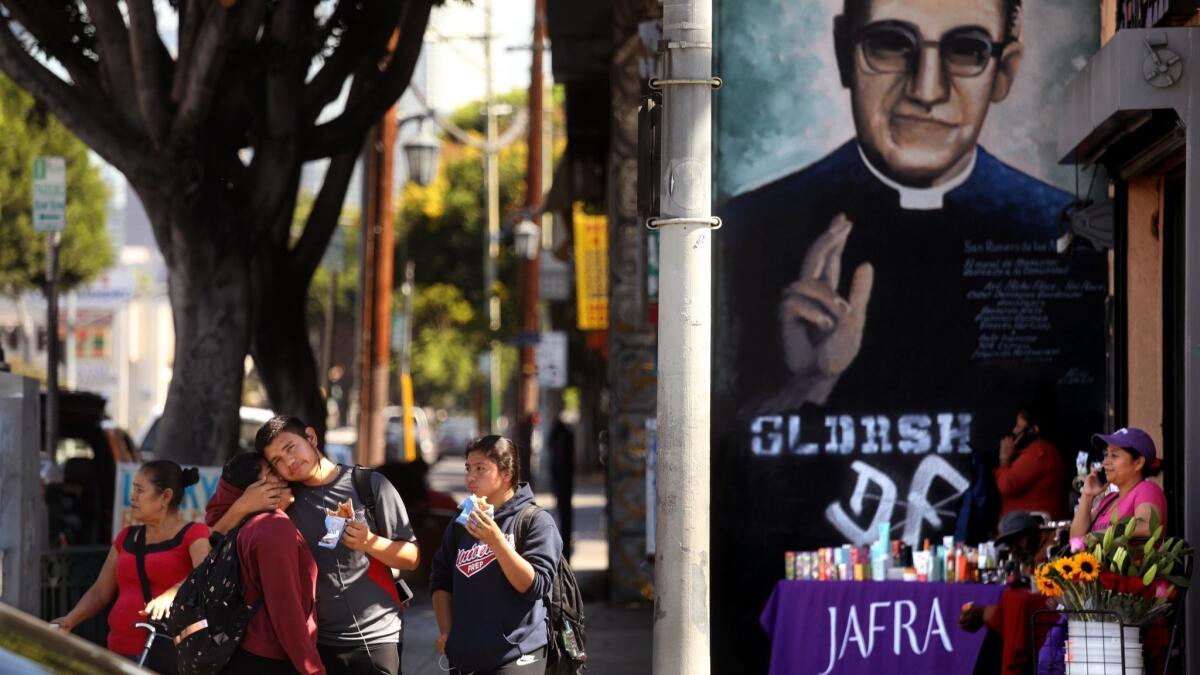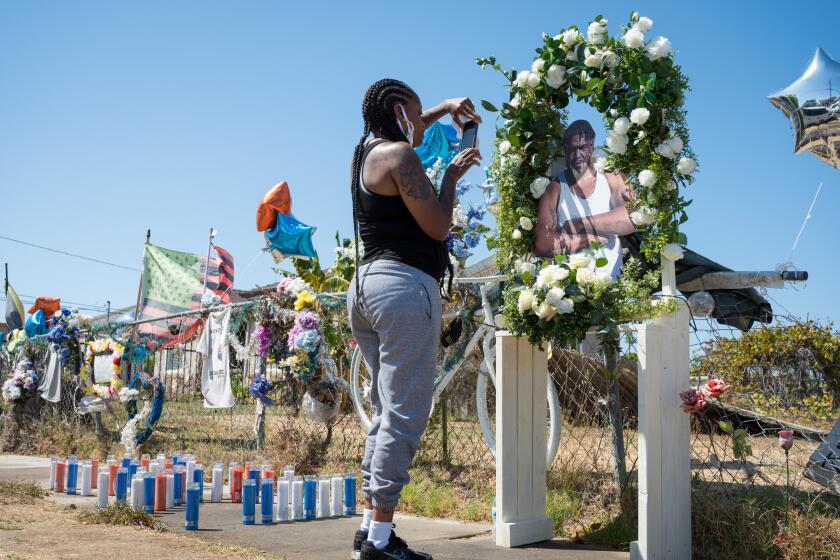On the eve of his canonization, Archbishop Oscar Romero is remembered by Salvadoran immigrants in L.A.

Oscar Levi Dominguez was 8 years old the last time his father took him to hear Archbishop Oscar Romero speak outside the Metropolitan Cathedral in San Salvador.
Romero, who implored the country’s right-wing government to do more for the poor and was an outspoken critic of the repressive tactics of the military, was a regular part of Dominguez’s young life: He baptized him and gave him communion.
One Sunday Romero was in the middle of Mass when gunfire erupted in the crowd.
There was panic. Dominguez said his father took him by the hand and they fled to the National Palace, where they hid until things quieted down.
Romero survived the incident, only to be killed a few weeks later while celebrating Mass in a hospital chapel. An unknown assailant approached the altar and shot Romero in the heart.
Dominguez, now 45 and the president of the El Salvador Community Corridor along Vermont Street in the Pico Union neighborhood, said he thinks of Romero often.
As the Vatican readies to canonize the heroic bishop this weekend, Los Angeles’ large population of Salvadoran immigrants are remembering the man they called Monseñor Romero.
“He had the heart to empower people,” Dominguez said from his small office on Vermont Street, holding a small scarf emblazoned with Romero’s image. “He had the heart to fight injustice. He gave poor people hope that someone was going to stand up against the violence and the government.”
Romero’s image is found scattered around the neighborhood. The intersection of Pico Boulevard and Vermont Avenue is officially known as Oscar Romero Square.
There are two murals of him at the intersection, including one overlooking a bus stop that is painted on the walls of the Pulgarcito, a family restaurant that specializes in Salvadoran food.
“Nobody has painted over it,” said Nelsy Valdez, 24, the granddaughter of the Salvadoran woman who started the restaurant in the early 1990s. “People today still have a lot of respect for him.”

Valdez’s parents grew up in El Salvador near Usulutan, but she was born in the United States and didn’t know much about Romero until after the intersection was named after him around 2012.
She learned about his impact on the poor and the reverence many in her family — even those who are not Catholic — hold for him.
“He is like the pope of El Salvador,” she said.
Forty-five-year-old Yesenia Seepas, who works as a travel agent along Vermont, still remembers the daily terror that came with growing up during El Salvador’s civil war during the 1980s.
She and her family would hide under their beds when gunfire broke out near their hometown of San Buenaventura. She still remembers seeing bodies hung by their feet, sometimes without their heads.
It could be a hopeless place to grow up. But Romero’s Masses were sometimes broadcast on the radio and inspired hope, Seepas remembered, simply for their honesty about the country’s struggles.
“He fought for human rights, he defined the poor and he told the truth — that’s why he was killed,” she said in Spanish, shaking her head slowly.
It is important to her that he is remembered by new generations of Salvadoran immigrants in the United States. She hopes his canonization will ensure his place in history. .
“It has been a long time coming and a long fight,” she said.
A few blocks away Gloria Elisabeth Mancia, 62, sat underneath a tent and tended to her table where she sells mangoes, red beans and tamales. She tried to recall Romero’s impact when he was alive.
Mancia was in her 20s when Romero was delivering his sermons and growing into a popular activist figure among the poor. But she didn’t get to know him and his history until after his assassination.
That’s when he achieved larger fame throughout the country.
“He inspired a lot of us,” she said.
Here is more about Romero from the archives of the Los Angeles Times:
What is Romero’s story?
Born in 1917, Romero began his career in the church as a relative conservative. But years of seeing how El Salvador’s poor were mistreated by a handful of rich oligarchs turned him against the elite. He was spurred to social action a few weeks after being appointed archbishop in 1977, when a fellow priest who had called for workers rights was slain.
It was the early days of El Salvador’s civil war, which pitted rebels against a right-wing government backed by the United States.
In homilies and widely broadcast radio shows, Romero implored the government to do more for the poor and criticized the repressive tactics of the military. He gained international recognition when he wrote a letter to President Carter asking the U.S. to stop military aid to El Salvador.
The day before he was killed, Romero delivered a sermon begging soldiers not to obey orders to kill civilians. “In the name of God … I beg you, I beseech you, I order you to stop the repression,” he said.
The next evening, while delivering a Mass at a chapel in a hospital, an unknown assassin approached the altar and shot Romero through the heart. Although no one was convicted of the crime, a United Nations truth commission concluded in 1992 that army Maj. Roberto D’Aubuisson gave the order.
Chaos ensued at Romero’s funeral, and dozens of people were killed. The left and the right blamed each other for sparking the violence.
That incident and Romero’s death were seen as key events at the start of El Salvador’s 12-year civil war, in which 75,000 people were killed and thousands disappeared.
What was Romero’s path to sainthood?
There was talk of sainthood in the wake of his assassination, but it’s been a long road.
Conservatives within the church long blocked efforts to name Romero a saint, arguing he was slain for his politics, not his religion. The case for Romero’s canonization stalled at the Vatican under the papacy of John Paul II, part of a generation of clergy who disliked Romero’s associations with liberation theology — a movement that argued that while clergy members should care for the poor, they also should push for political changes to end poverty.
Pope Francis, a Jesuit from Argentina who became pope in 2013 and whose core belief is helping the poor, has made Romero’s ascension a priority. He cleared the way for him to be beatified in 2015 and now for canonization, the last step to sainthood.
Francis announced the sainthood move in May.
Why is Romero such a powerful symbol in Los Angeles?
Hundreds of thousands of Salvadorans fled to Southern California in the 1980s to escape the civil war and continue to emigrate here today.
Romero’s activism became a symbol of hope, and he long has been a highly honored figure.
In 2013, a plaza was established in his honor at 7th and Alvarado streets in the Westlake neighborhood of MacArthur Park, home to many Salvadorans.
In announcing the plaza, Mayor Eric Garcetti said the monument will be a “symbol that shows our city stands in agreement with Romero’s principles.”
“This is more than a monument of a man,” Garcetti said at the time. “This is a monument that salutes courage, humanitarianism and the rights of the poor.”
More to Read
Start your day right
Sign up for Essential California for news, features and recommendations from the L.A. Times and beyond in your inbox six days a week.
You may occasionally receive promotional content from the Los Angeles Times.







